

| WE HAVE JUST THE TOUR YOU ARE LOOKING FOR | |
|
Durrington WallsSome of the most exciting finds from the Neolithic period in recent years have been discovered at Durrington Walls, nearly 2 miles north-east of Stonehenge. From 2003 a team led by Professor Mike Parker Pearson of University What is Durrington Walls?It is Britain's (and therefore the worlds!) largest henge measuring nearly 500 metres in diameter. Not quite circular, it originally had four entrances of which only one is now clearly visible. The internal ditch was about 5 metres deep and in excess of 10 metres wide. The material dug out of the ditch was used to create an external bank some 3 metres high. It was built around 2500 BC and probably in one season making it an even more remarkable feat. From the finds that have been made in the last few years it may be that Durrington Walls is where the builders of Stonehenge lived. What has been found at Durrington Walls? The first major dig took place in 1967 when a new road was being built Most of the timber circle at Durrington Walls is buried beneath the road, but part of it was excavated in 2006. As we can see above some of the posts were massive and timber of that size did not exist in the area at the time it was erected around 2500 BC or earlier. A much smaller timber 'circle' was also found, but this is now buried beneath the road. Similar features have been found to the south of Woodhenge nearby. Leading down to the River Avon next to Durrington Walls is an Avenue made up of a double layer of compacted flint. It runs from the entrance to the Southern Circle for a distance of over 100 metres. It is the oldest metalled surface in Europe and when part of it was uncovered in 2005 it glistened in the early morning dew. In 2005 the first complete Neolithic house floors in England were In amongst the settlement was a midden. This contained some cattle and sheep bones, pottery, arrowheads, and large amounts of young pig bone. The way the pigs were raised and killed leads archaeologists to believe that they were consumed as part of feasting that took place on the site. Studying the artefacts found in the midden will allow the Stonehenge Riverside Project to build up a clearer picture of life in the Neolithic and increase our understanding of Stonehenge's role within the wider landscape. Theories about the role of Durrington Walls.One of the great mysteries from all of the archaeological digs that have taken place in the immediate area around Stonehenge is the lack of evidence of day-to-day activities. It is as if Stonehenge was erected in isolation of a community. Building a wonderful monument such as Stonehenge must have taken large numbers of people who would have been in need of shelter and food during their mammoth task. The Stonehenge Riverside Project lead archaeologist, Professor Mike Parker Pearson,believes that Durrington Walls is the land of the living (and recently departed), while the area around Stonehenge is the land of the ancestors. They are linked by Avenues from both monuments which in turn are linked by the River Avon which flows between their two ends. Another archaeological dig took place in August 2016. What can be seen in the area now?Sadly the trenches are filled at the end of each seasons dig. We can, however, still see the remains of the ditch and bank of the henge, and Woodhenge which is next to Durrington Walls. Having worked on the dig for several years providing tour guiding services to the thousands of people who visit each year our tour guide can show you; the extent of Durrington Walls, explain how it was built where the Southern Circle was along with its Avenue where the Neolithic houses and midden were found explain the other archaeological finds in the area explain the Stonehenge Riverside Project's theory on Durrington Walls and its role in the wider landscape. We can include a visit to Woodhenge, the Cursus, the Avenue and, of course, Stonehenge in the tour to paint you a full and vivid picture of this historic and beautiful landscape as seen on the PBS program Secrets of Stonehenge. See our tours to the inner circle for more details. Please do contact us for further details about your tour. In September 2014 a report on some geophysics was published which highlights some new findings, but as yet not dug. You can read a summary on our blog post.
|

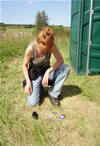
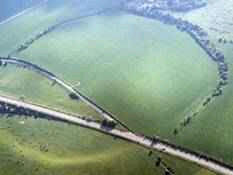 College London carried out an archaeological dig for four weeks each year in the area and made some ground breaking finds. Under the banner of the Stonehenge Riverside Project, it is a research dig involving five universities with sponsorship from National Geographic and support from English Heritage and the National Trust. Up to 120 archaeology students along with some of the leading archaeologists of the Neolithic period in the world worked on site for the 4 weeks each year.
College London carried out an archaeological dig for four weeks each year in the area and made some ground breaking finds. Under the banner of the Stonehenge Riverside Project, it is a research dig involving five universities with sponsorship from National Geographic and support from English Heritage and the National Trust. Up to 120 archaeology students along with some of the leading archaeologists of the Neolithic period in the world worked on site for the 4 weeks each year.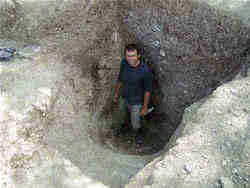 which now, sadly, bisects the henge. A timber circle, known as the Southern Circle, 40 metres in diameter consisting of 6 rings of posts was found. More recent work has discovered that the entrance to the circle is aligned on the winter solstice sunrise ie the complete opposite of Stonehenge.
which now, sadly, bisects the henge. A timber circle, known as the Southern Circle, 40 metres in diameter consisting of 6 rings of posts was found. More recent work has discovered that the entrance to the circle is aligned on the winter solstice sunrise ie the complete opposite of Stonehenge. 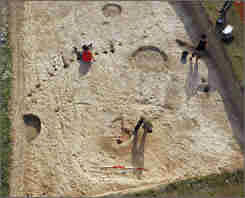 discovered by the Stonehenge Riverside Project at Durrington Walls during the dig. These have been excavated, but 2007 may well be the last year they were exposed. Measuring just 5mx5m they have a very similar floor plan to houses built in stone found on the Orkneys.
discovered by the Stonehenge Riverside Project at Durrington Walls during the dig. These have been excavated, but 2007 may well be the last year they were exposed. Measuring just 5mx5m they have a very similar floor plan to houses built in stone found on the Orkneys. 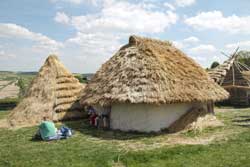 The Durrington Walls houses are of timber and plaster and heavily ploughed away. It is estimated that hundreds or perhaps a thousand or more of these little houses ran along the valley side. A reconstruction of these houses will form part of the new visitors centre at
The Durrington Walls houses are of timber and plaster and heavily ploughed away. It is estimated that hundreds or perhaps a thousand or more of these little houses ran along the valley side. A reconstruction of these houses will form part of the new visitors centre at